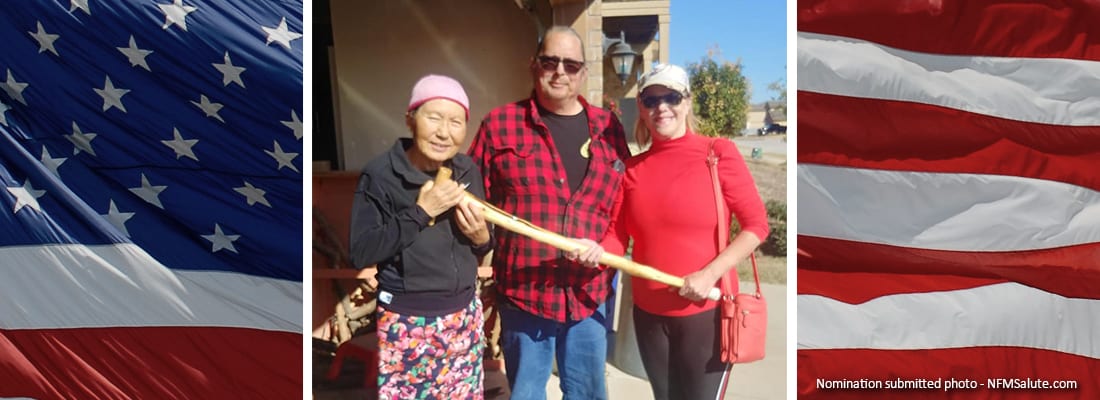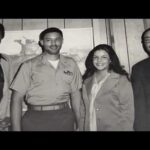NFM Lending is pleased to honor Corporal Jamie Willis, USA, Retired, as the NFM Salute for November 2020.
Jamie Willis joined the U.S. Army in 1989 as a Cavalry Scout. During his military career, Willis was a member of 4th Squadron, 7th Cavalry in Korea, and 2nd Squadron, 2nd Cavalry Regiment. In 1991, he served in Saudi Arabia with A Troop in the 1st Squadron, 7th Cavalry Regiment as part of Operation Desert Shield, and later in Operation Desert Storm. Willis remembers, “It was a rough time, not really knowing when we first deployed how long we would be there [or] what the situation would actually be like. After seeing what happened on the news before we deployed–the threat of chemical warfare–and just freshly being in the Army, it was a real terrifying time.” During this tour, Willis was severely injured in an accident with a Bradley Fighting Vehicle. His back sustained the most damage, and Willis was told he may never walk again. Miraculously, he began to take his first steps a few weeks after. The pain from the injury, however, did eventually force him into an early medical retirement in 1998.
Due to his specialized role in the military and his limited physical range, it was difficult to reintegrate into civilian life. During the first several years, Willis took jobs that were less physically demanding, including: gas station clerk, school bus driver, mechanic, and a garbage man. In 2006, he reentered the military world and worked on the MRAP (Mine-Resistant Ambush Protected) vehicle project. He started MRAP University as an instructor in Texas, and later traveled the U.S. and overseas training service members until 2014.
Eventually, the mental and physical injuries Willis received during combat caught up to him, manifesting themselves in an extremely painful way. Willis suffered with chronic back pain from his accident and was considered 100% disabled by the Department of Veterans Affairs. The combination of being unable to work and PTSD left Willis often contemplating suicide. His life completely changed when he decided to find an alternative to the unstable, “ugly” metal canes issued by the VA. After researching a better, more attractive cane, Willis reached out to Free Canes for Veterans, a volunteer project based in Florida. When he was told the waitlist to receive a hand-carved cane was full, he was contacted by the head of the organization, Oscar Morris, who taught Willis how to make his own.

By Alena Kairys
Nov 2, 2020
LINTHICUM, MD, November 2, 2020— NFM Lending is pleased to honor Corporal Jamie Willis, USA, Retired, as the NFM Salute for November 2020.
Jamie Willis joined the U.S. Army in 1989 as a Cavalry Scout. During his military career, Willis was a member of 4th Squadron, 7th Cavalry in Korea, and 2nd Squadron, 2nd Cavalry Regiment. In 1991, he served in Saudi Arabia with A Troop in the 1st Squadron, 7th Cavalry Regiment as part of Operation Desert Shield, and later in Operation Desert Storm. Willis remembers, “It was a rough time, not really knowing when we first deployed how long we would be there [or] what the situation would actually be like. After seeing what happened on the news before we deployed–the threat of chemical warfare–and just freshly being in the Army, it was a real terrifying time.” During this tour, Willis was severely injured in an accident with a Bradley Fighting Vehicle. His back sustained the most damage, and Willis was told he may never walk again. Miraculously, he began to take his first steps a few weeks after. The pain from the injury, however, did eventually force him into an early medical retirement in 1998.
Due to his specialized role in the military and his limited physical range, it was difficult to reintegrate into civilian life. During the first several years, Willis took jobs that were less physically demanding, including: gas station clerk, school bus driver, mechanic, and a garbage man. In 2006, he reentered the military world and worked on the MRAP (Mine-Resistant Ambush Protected) vehicle project. He started MRAP University as an instructor in Texas, and later traveled the U.S. and overseas training service members until 2014.
Eventually, the mental and physical injuries Willis received during combat caught up to him, manifesting themselves in an extremely painful way. Willis suffered with chronic back pain from his accident and was considered 100% disabled by the Department of Veterans Affairs. The combination of being unable to work and PTSD left Willis often contemplating suicide. His life completely changed when he decided to find an alternative to the unstable, “ugly” metal canes issued by the VA. After researching a better, more attractive cane, Willis reached out to Free Canes for Veterans, a volunteer project based in Florida. When he was told the waitlist to receive a hand-carved cane was full, he was contacted by the head of the organization, Oscar Morris, who taught Willis how to make his own.
Willis soon made his very first cane, but he did not want to stop with himself. The experience of handcrafting a mobility tool made him realize other Veterans deserved to have a cane that gave them a sense of dignity. With his newfound sense of purpose, Willis started his own branch, Canes for Veterans Central Texas, in 2016. Since then, Willis and his team of volunteers have made over 400 canes distributed to Veterans and civilians in the U.S. and around the world. The canes are made from scraps of wood, either donated or found by Willis. In January, news of his cane-making went nationwide as he had asked for local Christmas trees to be donated to him instead of discarded. Before he knew it, Willis had thousands of trees donated from across the country.
Willis says the symbolism of using Christmas trees to make canes was told to him by Morris. He explained, “The Christmas tree and the Veteran are very similar. If you think about the Christmas tree and the service member, they’re treated the same. They’re taken when they’re young, they’re decorated up, they’re used, and at the end of the season, they’re both thrown away. I’m taking that Christmas tree and I’m stripping it back down and starting over. Then I turn it into a cane. It’s solid again–it’s strong–and I give it to the Veteran as a symbol; to show them you’re still solid, you’re still strong, you’re still worth something. When you explain that to them, they stand a little taller. They puff their chest out a little bit and it just makes them feel good about themselves.”
Willis resides in Copperas Cove, TX, where he is keeping himself busy with the organization. He hopes to make and give away 1,000 canes in 2020.
NFM Lending is proud to donate $5,000 to Canes for Veterans Central Texas on behalf of Willis. NFM looks forward to the opportunity to continue to honor military and Veterans through the NFM Salute initiative.
Full Transcript of Video Interview is Below
– Welcome to our November NFM Salute. I’m your host, Greg Sher. November is such a special month for our Veterans. We’ve got Veterans Day and of course we’ve got later in the month, Thanksgiving. And what a special guest we have today to commemorate both. We’re gonna go down to Copperas Cove, Texas and welcome in Jamie Willis. He’s an Army Veteran, served in Desert Storm and also Desert Shield in the early ’90s. Jamie, thank you for being with us on NFM TV. How are you?
– I’m doing great, and I’m happy to be here with you.
– Let’s first start off with your years of service. You gave this country over 10 years. What can you tell us about your time overseas in Desert Storm and Desert Shield?
– It was a rough time. Not really knowing when we first deployed how long we would be there, what the situation would actually be like, the threat of chemical warfare. It was a real terrifying time. I mean, just driving around, you know, you’d see burnt vehicles with bodies hanging out. It’s just not something that, being that young, I was really prepared to see. But you also have that feeling of, you know, I joined the Army to serve my country, and this is exactly what I’m doing, and this is exactly what I signed up for.
– You took me on a tour around your house a couple of days ago, and you’ve got a flag on nearly every wall. Why is the flag so important to you?
– The flag represents our freedom. It’s what I fought for. It’s what I served for. I even have flag boots on.
– Prove it. Please, prove it. I need you to prove it. Come on, take one of those things off. I’ve never heard of flag boots. Wow, amazing. Those are gorgeous. Jamie, I cannot wait to share what you’ve been able to accomplish in your life giving back to Veterans. But before we do that, I want to talk about what it was like for you to re-immerse yourself in society when you got back from Desert Shield and Desert Storm. You had quite a few jobs. What was it like to put yourself back in society?
– It was hard. I mean, I did enjoy some of the jobs like driving the school bus. I enjoyed working with the kids, but there was still something missing. And then I came back to working with the military.
– And indeed you did go right back to your passion, your love for military, You are an expert in the MRAP vehicle. The acronym is Mine Resistant Ambush Protected. Tell us about your experience training other soldiers how to navigate that very powerful device for eight years.
– Yes, I worked on the MRAP project. I started out at what they call MRAP University up in Texarkana, Texas as an instructor. The power of it is pretty amazing. It’s designed to where if it takes a blast from underneath the soldiers inside are safe.
– [Greg] And what’s it like to be in it when a device does detonate from underneath it?
– It’s scary. It’s really scary. It’s loud. But if you’re strapped in correctly, it can save your life.
– And so now you have decided to give back to others. You’ve got such a remarkable mission and journey you’re on through Canes For Veterans Central Texas. You make canes for other Veterans. How many canes have you made to date and what got you into giving back in that way?
– Today, we’ve made a little over 400 canes. And what got me into it is from my back injury, back in Desert Storm, from over the years, my back has gotten worse and worse, and I needed the use of a cane. Well, the cane that the VA gave me, the metal cane kept breaking. So I contacted a gentleman in Florida who’s also doing the same thing I’m doing now, but he sat down and walked me through this process of making canes.
– When you first started out on your mission, you were actually going to the curb side of people’s homes and taking debris, anything having solid wood. And you would sit there with a handsaw and cut the wood, right on site.
– Yes, last year I put it up on my page here in my local community to don’t throw out your Christmas trees, that I’ll take your Christmas trees. And it just blew up overnight. And the next thing I know CNN was calling me, and I received over 3600 Christmas trees.
– I want you to pull one of those canes out. I understand you’ve got a few with you right now. Show us what the canes are made of. You can just grab one cane for me and show us exactly what it looks like.
– Yeah, this one is made from a Christmas tree, and I’ve stripped all the bark off of it. This one’s going to a gentleman who was in the 9th Infantry Division during Vietnam. It’s got a cedar handle. Every handle we do ends up with a round in the end of it, a spent casing. It’s coated with epoxy.
– Jamie, you talked to me, as we were getting to know each other, about the symbolism between the cane and the man. Can you expound on that for our audience?
– If you think about the Christmas tree and the service member, they’re treated the same. They’re taken when they’re young, they’re decorated up, they’re used. And at the end of the season, they’re both thrown away. But what I’m doing is I’m taking that Christmas tree. I’m stripping it back down and starting over. Then I take it, and I turn it into a cane. It’s solid again. It’s strong. And I give it to the Veteran as a symbol to show that, you know, you’re still solid. You’re still strong. You are still worth something.
– Like I said, a perfect story for Thanksgiving. And I’m gonna take this a step further, because I know donations mean everything to you right now as you continue to get this 501c3 off the ground. Typically our donation is $2,500. I’m gonna up that to $5,000. It is Thanksgiving, and you look shocked. I just want to thank you. I know you’re doing so much for Veterans out there, and I know how much they appreciate you. And I’m hoping that $5,000 will really make an impact on your business.
– Hang on. Oh, I don’t know what to say. Oh, thank you.
– So we’ll get that check right out. And I also wanna guide people to go to vetcanes.com to make a donation. You can see how much a donation means to Jamie. He’s given his life for this country. And now he’s giving more of his time and sacrifice to appreciate other Veterans who have served. Jamie Willis, Army Veteran, and cane enthusiast, a flag lover, a USA lover. Really appreciate your time. And again, thank you so much for your service and for agreeing to be our November NFM Salute.
– Thank you.
– Thanks so much, Jamie. I’m Greg Sher from NFM TV. Hope you’ve enjoyed this special NFM Salute. We’ll see you next time.


